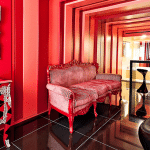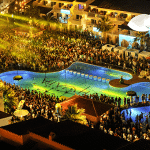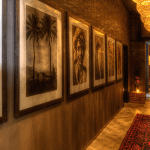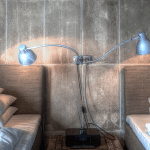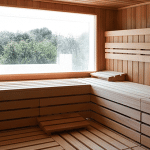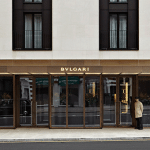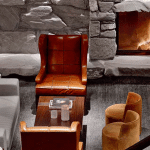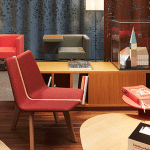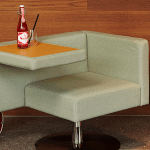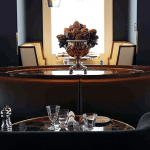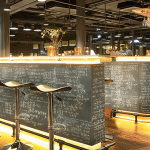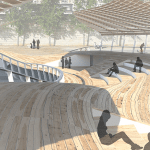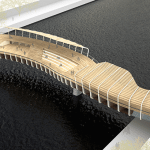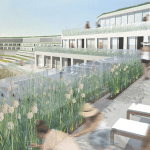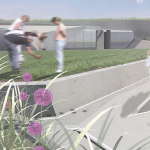Skift Take
The winning hotel designs at the 2013 European Hotel Design Awards focus as much on user experience and social interaction as they do aesthetic whimsy -- throughout the rate scale.
- VIP box, Ushuaïa Beach Hotel, Ibiza
- Ushuaïa Beach Hotel, Ibiza
- Speicher7 Harbour Hotel & Bar, Mannheim
- Speicher7 Harbour Hotel & Bar, Mannheim
- Castell dels Hams, Mallorca
- Castell dels Hams, Mallorca
- The Bulgari Hotel, London
- The Bulgari Hotel, London
- Oslo Suite at The Thief, Oslo
- Oslo Suite at The Thief, Oslo
- The Alpina, Gstaad
- The Alpina, Gstaad
- 25hours Hotel, Zurich West
- 25hours Hotel, Zurich West
- Plum & Spilt Milk Restaurant at The Great Northern Hotel, London
- Plum & Spilt Milk Restaurant at The Great Northern Hotel, London
- Cuckoo’s Nest at The Radisson Blu Riverside, Gothenburg
- Cuckoo’s Nest at The Radisson Blu Riverside, Gothenburg
- KOI Rendering by MM Planners
- KOI Rendering by MM Planners
- Rendering, James Young, Canterbury School of Architecture
- Rendering, James Young, Canterbury School of Architecture
- Ian Schrager
The winners of the 16th annual European Hotel Design Awards were announced this week in London, recognizing hotels ranging from a super-luxe Swiss chalet to a twirly little river bridge hotel. “Europe’s longest running and most prestigious architecture and design awards for the hospitality sector” is affiliated with the annual Sleep exhibition, showcasing trends in hotel interior product design.
Every year, the breadth of intelligent, innovative architecture throughout the 14 categories makes this event a true arbiter of what’s next in hospitality.
“Not only did we receive more excellent entries than ever before, but they were more diverse,” says Simon Ford, chair of the judging panel. “We look for creative excellence, commercial viability and evidence that the designs meet the needs of the client and guest alike. To my mind, the range, talent and fresh thinking seen in the work of this year’s winners amply demonstrate the pioneering quality of hospitality design today.”
Following are the 2013 winners, with excerpts from the judges’ comments.
Conversion of an Existing Hotel Building
Ushuaïa Beach Hotel in Ibiza is both a full-service beach resort and a massive outdoor nightclub, consisting of two different style buildings including the former Fiesta Hotel Playa d’En Bossa. Giant video panels line the facade to show passerby’s the packed DJ pool parties that start cranking everyday around noon. The conversion of the Fiesta Hotel into “The Tower” wing redesigned the rooms with moulded plastic beds, lava lamp-shaped furnishings and lots of hot tubs. All rooms, understandably, have blackout curtains.
The VIP Boxes are popular with candy-colored duotone palettes, a mishmash of Victorian/retro motifs, full hydromassage tubs, and upclose views of the bandshell and go-go dancer podiums. The hotel is also wired to the hilt so guests can communicate through their televisions with any other guest.
Judges comment: The risk taking and daring concept resulted in a property that is said to have changed the landscape of Ibiza forever.
Conversion of Existing Non Hotel Building
The 20-room Speicher7 Harbour Hotel & Bar is located on the Rhine River in Mannheim, Germany inside a warehouse originally built for wartime use. The concrete floors in the rooms are softened with plush rugs, all-natural fabrics, a mix of vintage/classic furnishings and adaptive-reuse furniture. Colors are muted to accentuate the industrial harbor views.
The outdoor bar terrace hangs out over the river, which is something new for Mannheim. There are no other boutique hotels in the area so the locals are all worked up over Speicher7’s artsy, creative class vibe. Like the hotel, the bar purports a “nouvelle vague” theme, which by definition means different things to different people, but always with an emphasis on “life, love and laughter.”
Judges comment: Preservation of the structure and its architectural detailing [means] the hotel is integrated into its neighborhood while also bringing a new social highlight to a formerly neglected area.
Newbuild Hotel
The Bulgari Hotel, London in the fancy-pants Knightsbridge neighborhood is described as “the perfect expression of the Bulgari aesthetic of timeless glamour.” Choosing the best hotel design of the year in Europe couldn’t have been easy in 2013. In fact, it couldn’t have been easy in London. Other nominees included the slick, Norman Foster-designed ME London and hipstery citizenM Hotel Bankside London.
The 85-room Bulgari boite feels important and takes itself seriously, with a lot of silver embellishments paying homage to the brand’s silversmith origins and Britain’s manufacturing traditions. That’s enhanced with rich dark woods and charcoal/chocolate tones, so it’s not entirely unlike sleeping in a Maybach. The hammered silver II Bar was created by Italian artisans, the ceiling is finished in titanium, the floor is black granite, and the walls are polished Sapele mahogany.
Judges comment: A masterpiece of intelligent architecture [is] exquisitely realized with exceptional attention to detail, giving London a gem of a new hotel.
European Hotel Design of the Year
The overall best hotel design award was given to The Alpina, Gstaad, which picked up two more awards for guest rooms and public spaces in the Interior Design categories. The challenge designing The Alpina revolved around building a 21st century luxury hotel in a conservative Swiss town that hasn’t welcomed a new resort in over 100 years.
The $330 million newbuild was constructed from reclaimed timbers and stone salvaged from nearby farmhouses, infusing the interiors with a nervy barnyard-chic energy. That’s complemented with the modern Japanese MEGU restaurant and Six Senses spa featuring a spectacular cave pool and treatment rooms resembling miner cabins.
Judges comment: Immaculate attention to detail…. The bedrooms offer a beautifully executed, modern, yet warm, take on the traditional Swiss chalet creating a luxurious alpine experience.
Specialty Awards
Every year, The Outstanding Contribution award is given to a hotel industry personality. This year’s winner is the visionary and seemingly omnipresent Ian Schrager, founder of Morgans, PUBLIC and EDITION Hotels.
Mr. Schrager has been a busy man lately with the opening of The London EDITION this year and a big reconstruction project for The Miami Beach EDITION opening next year. Both the London property and Schrager’s new PUBLIC Chicago hotel represent the next generation of luxury travel, combining classic elegance, modern furnishings, convivial staff, and a modern day reinterpretation of a Jazz Age social club spirit.
“It’s hard to think of an individual who has influenced contemporary hotel design more than Ian Schrager,” said Matt Turner, awards director and editor of Sleeper Magazine. “His contribution to the industry embodies innovation, passion and creativity—the very qualities the Awards seek to celebrate.”
The Reardon Smith Student Award applauds the social consciousness of student architects. This year, James Young at Canterbury School of Architecture proposed a ultra-lean, low-lying, low-impact design for a hotel project in Montenegro that integrates seamlessly with the coastal environment.
The look is almost Brutalist in tone, countered with judicious use of glass and negative space to show off the green landscape and ocean views. Young also stresses guest education classes in farming, gardening and organic cooking to complete the agri-tourism experience.
MM Planners won the Tomorrow’s Hotel award with their KOI project designed to enhance urban permeability. The snaking bridge is a multi-use, indoor/outdoor entertainment facility and hotel hybrid that provides public access across waterways in congested urban centers.
In effect, it links a city both economically and socially with an undulating physical presence paralleling both the movement of water below and the organic nature of urban pedestrian movement. The hotel would also make an exceptional rental facility for corporate group events.
Interior Design Awards
The 2013 European Hotel Design Awards included seven prizes dedicated to the different spaces inside hotels. For next year, Skift proposes that the judges consider adding an 8th category for meeting/event space. Here are this year’s winners, with links directed to the individual pages on the Awards website:
Lobby/Lounge: The Alpina, Gstaad welcomes guests with a reception desk hewn from an ash tree and a grand fireplace built out of local river boulders. Glass lighting overhead is etched with Swiss verses, sconces are hand-beaten bronze, and columns are wrapped with embossed leather.
Bed/Bath: The Alpina, Gstaad won its second interior design award with militant attention to detail in the residential-style guest rooms. Special touches include the carved alpine timber ceilings, leather-strapped cowbells used for bedside lighting, and custom hand-tufted carpet covers.
Suite: The Oslo Suite at The Thief penthouse unit has a private roof terrace with exclusive furniture by celeb designers Patricia Urquiola and Antonio Citterio. Windows stretch along the entire facade, making the interior space feel similar to the rooftop experience with spectacular panoramic views of the city.
Cafe/All Day Dining: 25hours Hotel, Zurich West is a perfect complement to one of Europe’s trendiest urban adaptive reuse communities. The NENI cafe is part lounge, restaurant and living room. Its playful interior with neon lighting and classroom-inspired furniture especially attracts Millennial creatives.
Restaurant: Plum & Spilt Milk Restaurant at The Great Northern Hotel, London is drop-dead gorgeous with a refined modern classicism, handmade Boffi furniture and 120 handblown light shades. Love the snug Art Deco bar.
Bar: Cuckoo’s Nest at The Radisson Blu Riverside, Gothenburg epitomizes the Radisson Blu brand’s impressive interior design mojo, setting the standard for mid-market corporate chains across the continent. The lighthearted tech/industrial theme tips its hat to Lindholmen Science Park next door.
Spa/Health: Castell dels Hams, Mallorca celebrates the island environment and soft light with myriad windows of various shapes throughout. The dancing light in the spa, spa pool and hydrotherapy tubs makes the building itself part of the wellness experience by immersing guests in the natural landscape.
Greg Oates covers hospitality trends and next generation hotels. He has participated in 1,000+ hotel site inspections in over 50 countries.
Have a confidential tip for Skift? Get in touch

